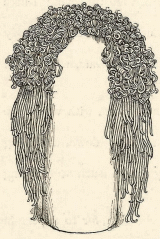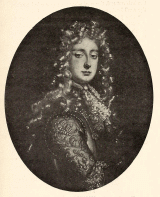The Dressing of the Hair, Moustachios and Beard (6)
Previous pageThe lofty Top-knots on her crown, with which she
sails abroad withal,
Makes me with care, alas ! look down, as having
now no hope at all,
That ever I shall happy be in such a flaunting
Wife as she.
In debt with every shop she runs, for to appear in
gaudy pride,
And when the milliner she duns, 1 then am forc'd
my head to hide Dear friends, this proud imperious wife she makes
me weary of my life.
Roxburghe Ballads, circa 1686
Wigs of various kinds have been in use from very early periods, as the grace and ornament which the hair imparts to the human frame have always been generally recognised. The want of it has ever been deemed a subject of reproach, held in ridicule, in all climes; hence the constant recourse to false hair.
 Strutt affirms that the beards of the Egyptians, as well as the coverings for the head, appear
to have been made of false hair, and removed when the face was shaved. There is no doubt that the Egyptians wore wigs, as examples are
to be seen in the British and other museums.
Strutt affirms that the beards of the Egyptians, as well as the coverings for the head, appear
to have been made of false hair, and removed when the face was shaved. There is no doubt that the Egyptians wore wigs, as examples are
to be seen in the British and other museums.The wig given in the illustration is probably a woman's, and was found near the small temple of Isis at Thebes. It belongs to the seventeenth dynasty, about B.C. 1500; it is formed of natural curlings of the hair in the upper portion, and the lower portion, which was originally much longer, consists of long, thin plaits, a number of which have been broken off and decayed, the thin plaitings contrasting very happily with the natural curls.
Lamprideses describes the wig of the Emperor Commodus as powdered with scrapings of gold, and oiled with glutinous perfumes for the powder to hang by.
Wigs first appear in England during the reign of Stephen, but are seldom mentioned until the Tudor period. The " Maiden Queen" is popularly supposed to have had her head shaved, and to have worn a wig. Mary Queen of Scots had a most complete collection of wigs, and it is recorded that she wore one at her execution.
 The periwig first appears in history as the headgear of a fool. In the privy purse expenses of
Henry VIII. for December, 1522, occurs the entry : " For a peryke for Sexton the King's fool xx shillings." By the middle of the same
century their use had become general, and it was dangerous for children to wander alone, as they were liable to be deprived of their
hair for the manufacture of these articles.
The periwig first appears in history as the headgear of a fool. In the privy purse expenses of
Henry VIII. for December, 1522, occurs the entry : " For a peryke for Sexton the King's fool xx shillings." By the middle of the same
century their use had become general, and it was dangerous for children to wander alone, as they were liable to be deprived of their
hair for the manufacture of these articles.The periwig blossomed out during the reign of Charles II, and attained enormous proportions; it was often gaily decked with ribbons and allowed to hang over the front and back for some distance.
The gossiping Pepys, complaining in his diary of October 30, 1663, of his extravagant purchases in wigs, clothes, &c., mentions, amongst other things, two periwigs, "one whereof cost me £3 and the other 4os. I have worn neither yet, but will begin next week, God willing."
"A Londoner into the country went,
To visit his tennants, and gather in rent;
He on a brave gelding did gallantly ride,
With boots and with spurs, and a sword by his side.
Because that the Innkeepers they will not score
He lined his pockets with silver good store;
And he wore a wigg cost three guineas and more;
His hat was cockt up, Sir, behind and before."
Roxburghe Ballads, 1688
Next Page 01 02 03 04 05 06 07 08 09 10 11 12